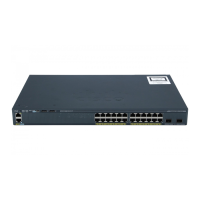Enabling UplinkFast for Use with Redundant Links
When you enable UplinkFast, it affects all VLANs on the switch or switch stack. You cannot configure
UplinkFast on an individual VLAN.
Note
You can configure the UplinkFast or the Cross-Stack UplinkFast (CSUF) feature for Rapid PVST+ or for the
MSTP, but the feature remains disabled (inactive) until you change the spanning-tree mode to PVST+.
This procedure is optional. Beginning in privileged EXEC mode, follow these steps to enable UplinkFast and
CSUF.
Before You Begin
UplinkFast cannot be enabled on VLANs that have been configured with a switch priority. To enable UplinkFast
on a VLAN with switch priority configured, first restore the switch priority on the VLAN to the default value
using the no spanning-tree vlan vlan-id priority global configuration command.
SUMMARY STEPS
1.
configure terminal
2.
spanning-tree uplinkfast [max-update-rate pkts-per-second]
3.
end
DETAILED STEPS
PurposeCommand or Action
Enters the global configuration mode.configure terminal
Example:
Switch# configure terminal
Step 1
Enables UplinkFast.spanning-tree uplinkfast [max-update-rate
pkts-per-second]
Step 2
(Optional) For pkts-per-second, the range is 0 to 32000 packets per
second; the default is 150.
Example:
Switch(config)# spanning-tree uplinkfast
max-update-rate 200
If you set the rate to 0, station-learning frames are not generated,
and the spanning-tree topology converges more slowly after a loss
of connectivity.
When you enter this command, CSUF also is enabled on all nonstack
port interfaces.
Returns to privileged EXEC mode.end
Example:
Switch(config)# end
Step 3
Catalyst 2960-XR Switch Layer 2 Configuration Guide, Cisco IOS Release 15.0(2)EX1
OL-29424-01 95
Configuring Optional Spanning-Tree Features
Enabling UplinkFast for Use with Redundant Links

